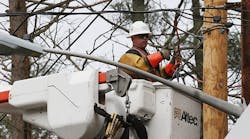Brett Brenner, president of the Electrical Safety Foundation International (ESFI), and Institute of Electrical and Electronics Engineers (IEEE) Senior Member James C. Cawley, P.E., will co-present a new paper that examines the occupations most at-risk for fatal overhead power line instances on Jan. 29 at the 2015 IEEE IAS Electrical Safety Workshop taking place this week in Louisville, Ky.
The paper, titled “Occupations Most At-Risk in Fatal Overhead Power Line Incidents: Using OSHA Data to Get a Better Understanding,” examined all electrical cases investigated by OSHA from 2000-2011 to determine the industries and occupations that often sustain injuries from overhead power line incidents as well as the scenarios associated with these events.
“Overhead power line injuries have outnumbered all other types of electrical injury since the Bureau of Labor Statistics began tracking these incidents in 1992,” said Brenner. “We conducted the necessary research and published our findings to raise awareness among these at-risk industries and occupations and help reduce overhead power line injuries and fatalities.”
The report found that the industries with the highest number of fatal overhead power line electrical injuries are, in order: power line construction, electrical work, roofing, electrical services (utilities), ornamental shrub and tree services, asbestos and lead pain removal services, painting and concrete work. The occupations with the highest number of fatal overhead power line injuries are, in order: electrical power installers and repairers, construction laborers, supervisors for electricians and power transmission installers, non-construction laborers, construction trades, painters, carpenters, roofers, electricians and truck drivers.
“While it should come as no surprise that most overhead power line injuries occur in occupations that work on overhead power lines, such as line workers, we also found that a significant number of fatalities were attributed to occupations that don’t directly involve power lines, such as laborers, painters, roofers, truck drivers, and farmers” said Cawley. “This evidence demonstrates a need for overhead power line safety training beyond those who expect to have direct contact with power lines.”
The report noted: “Many occupations that are not usually associated with OHPL-job responsibilities are fatally injured in the course of work performed in the vicinity of OHPLs. Conductive ladders, aluminum siding, sheet metal, metallic poles and handheld objects are frequent elements in OHPL electrocutions for painters, siding mechanics and tree trimmers.”

